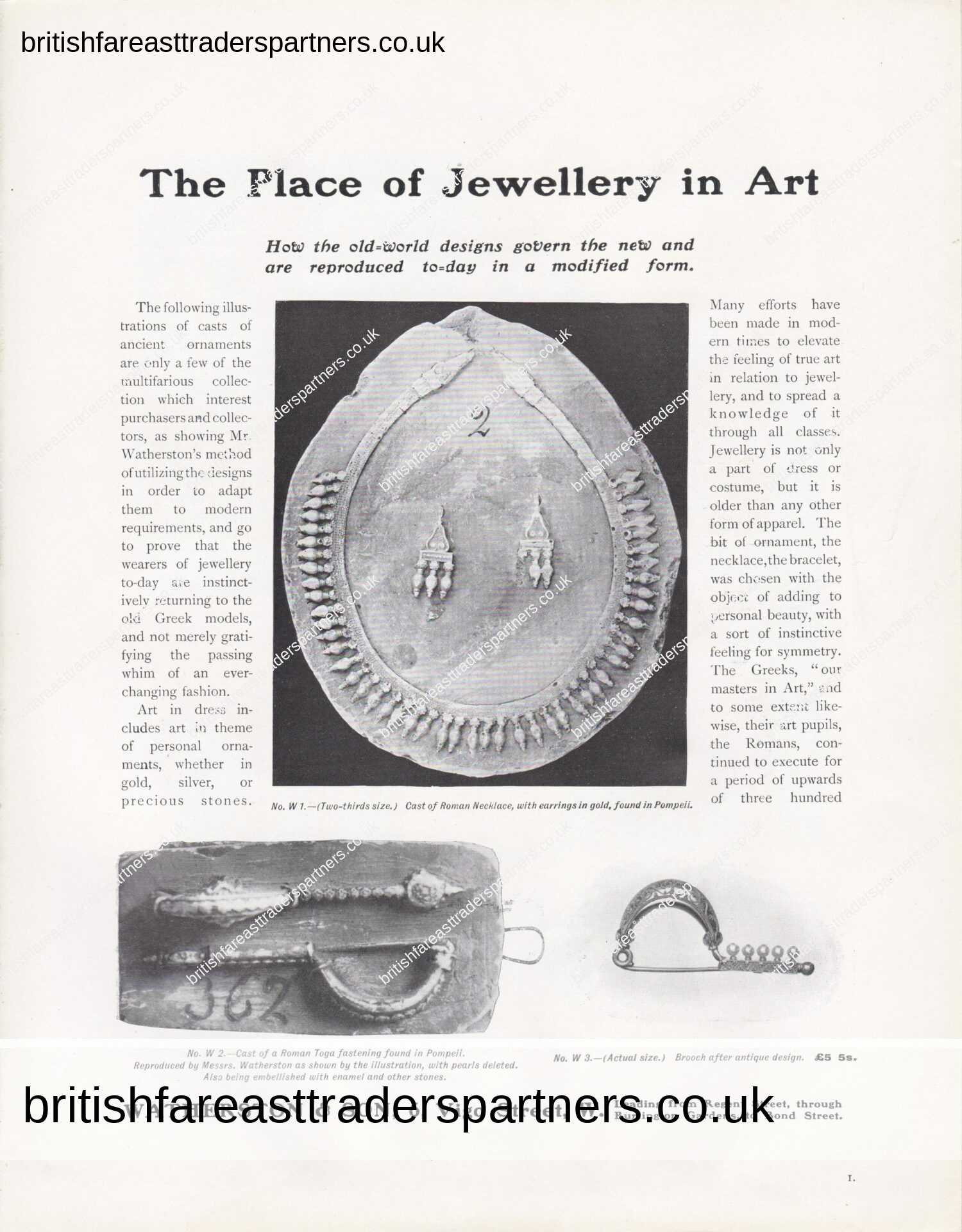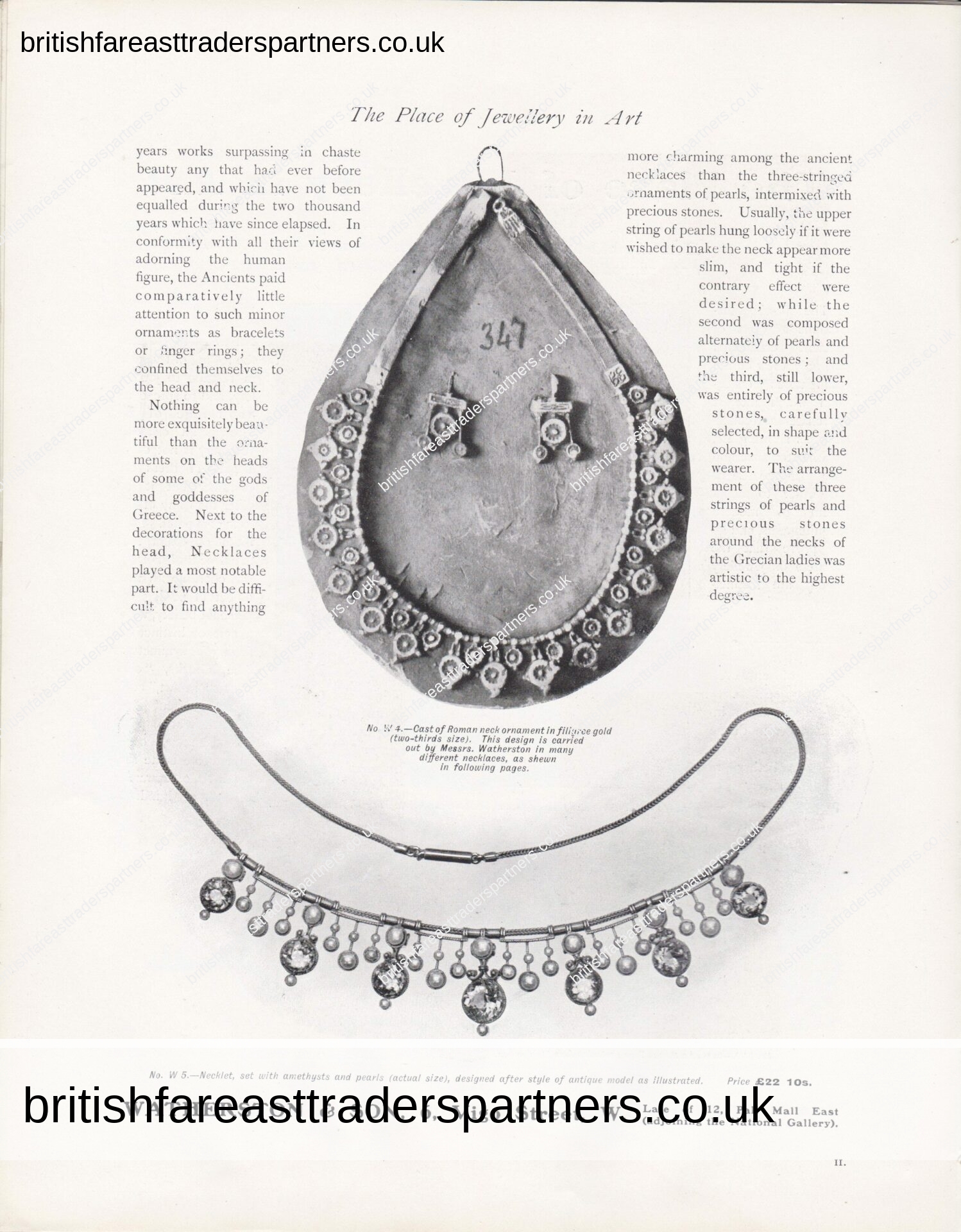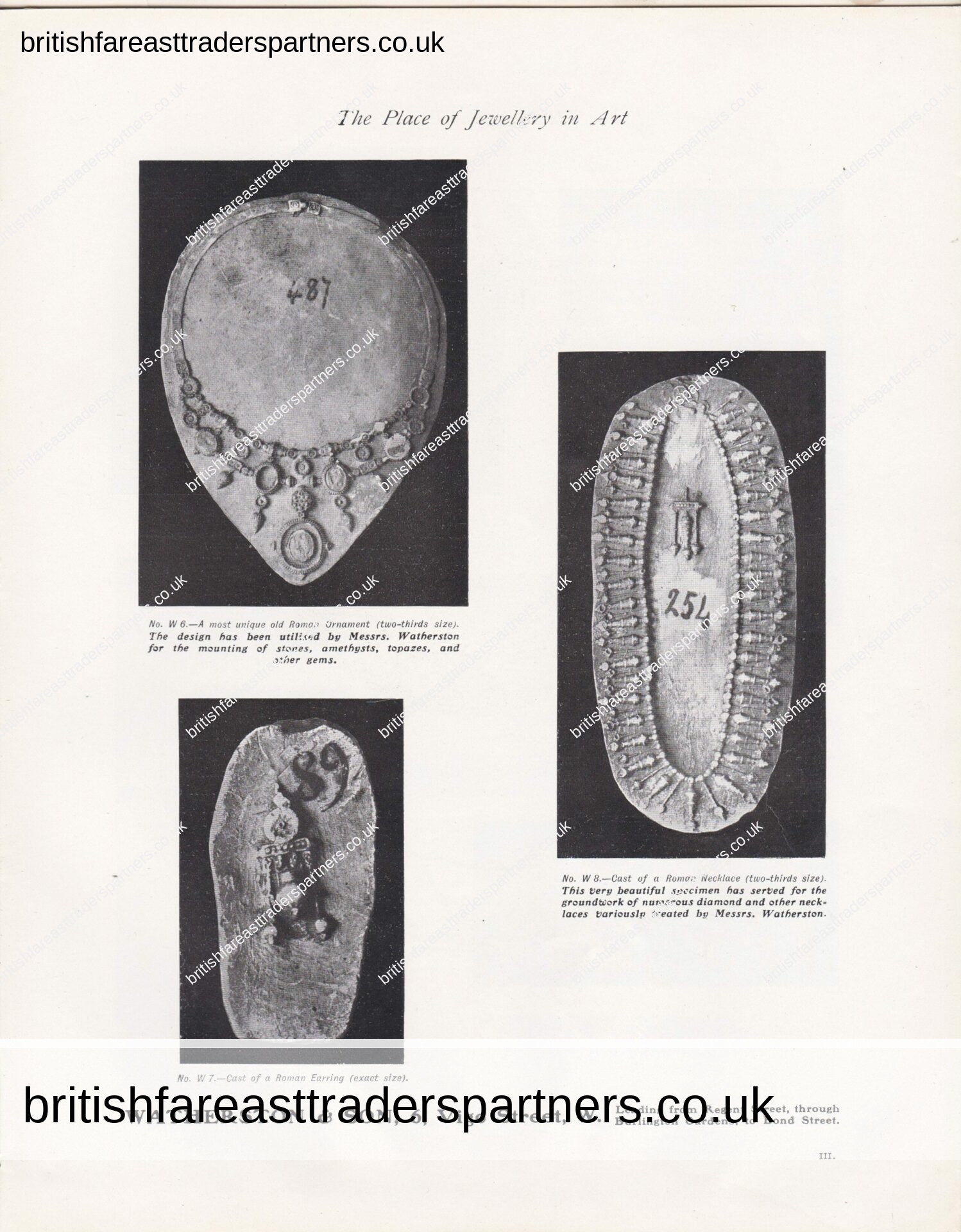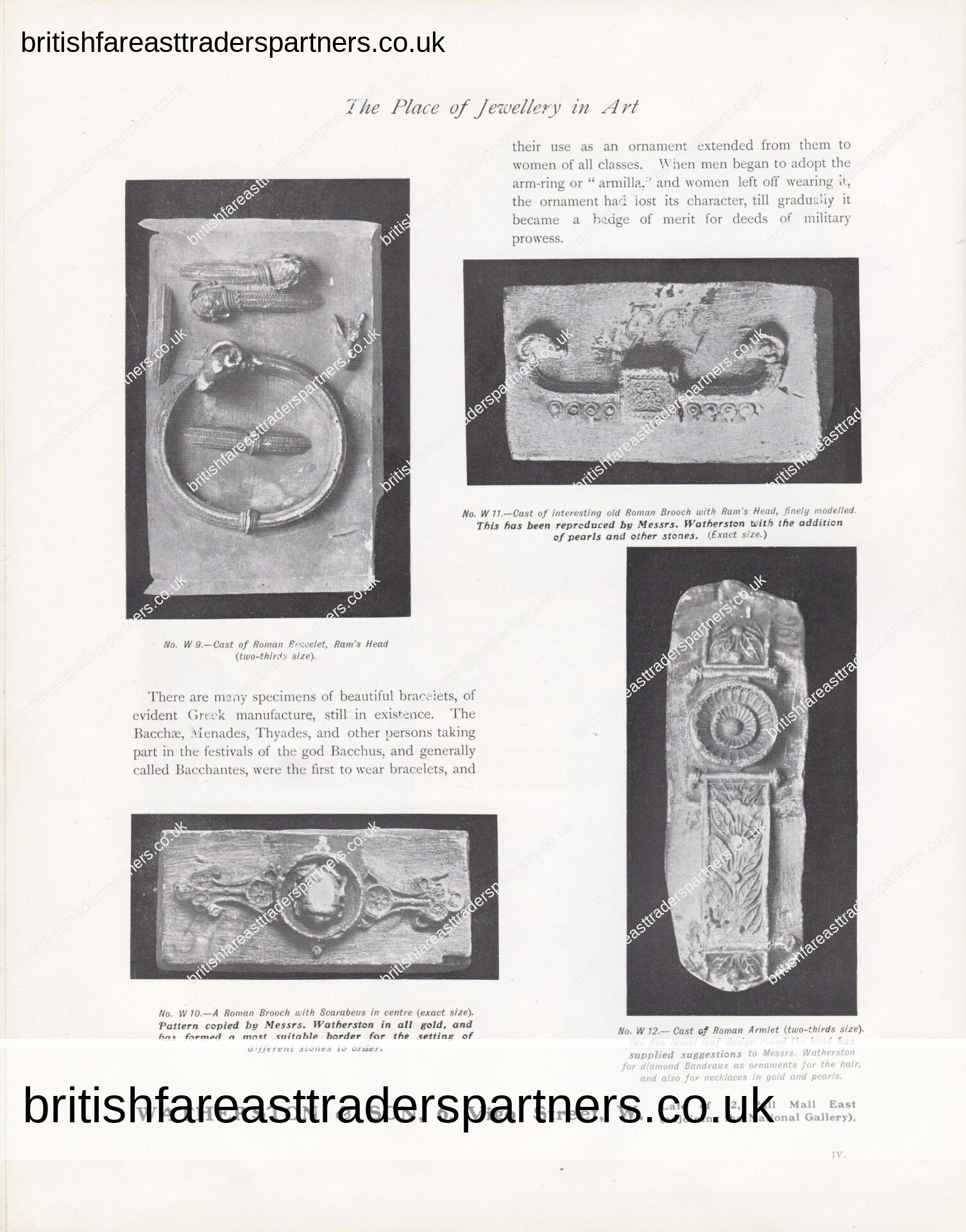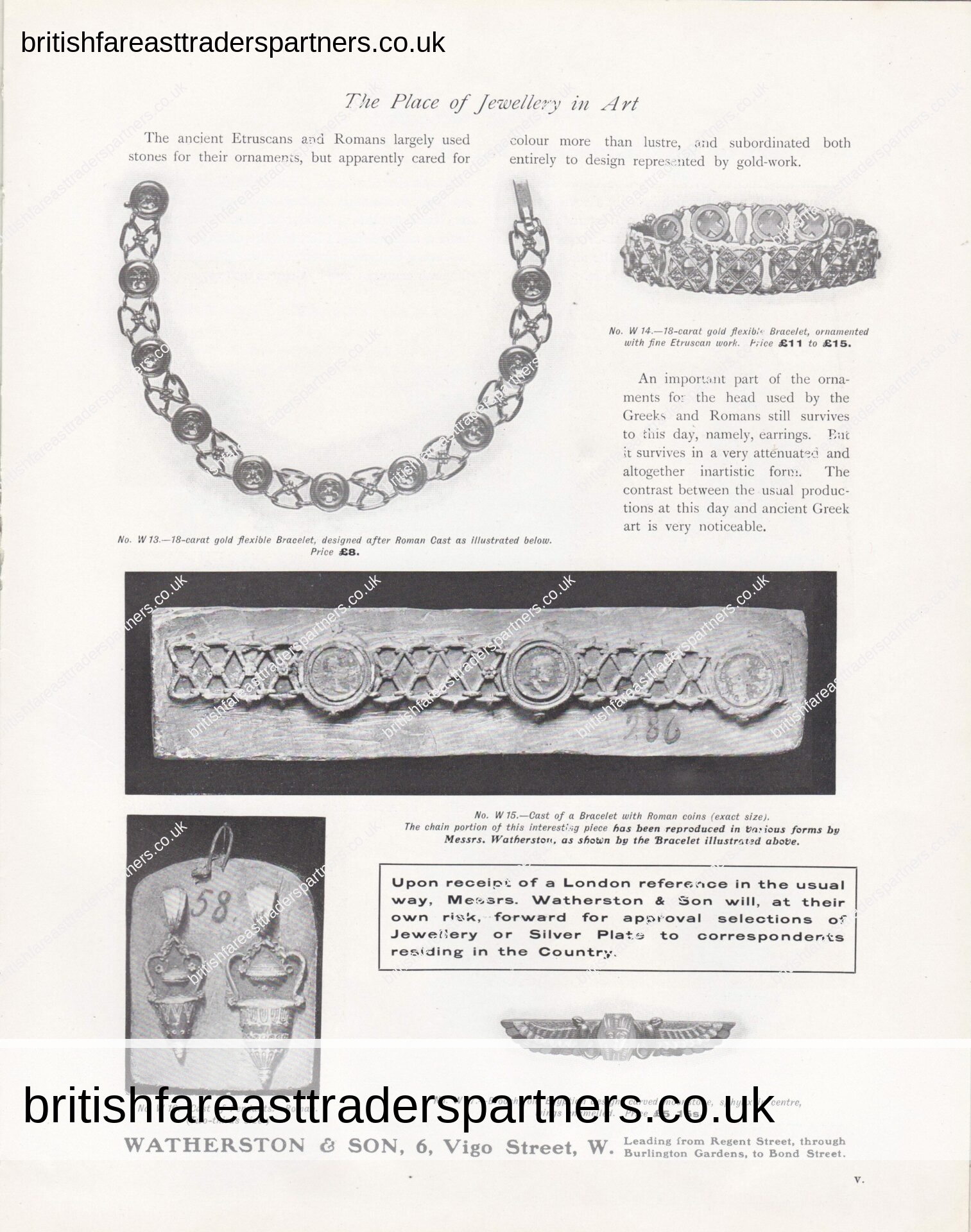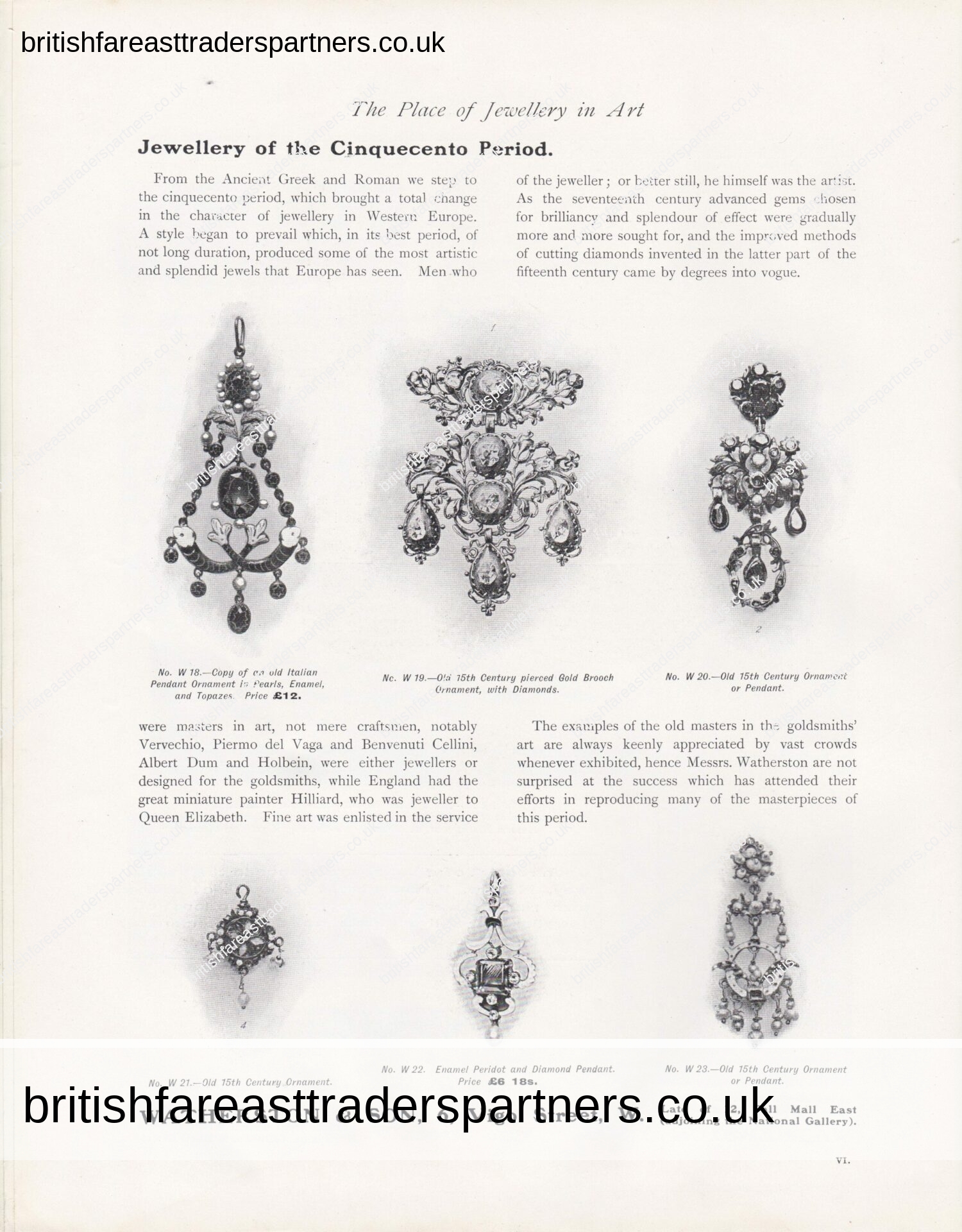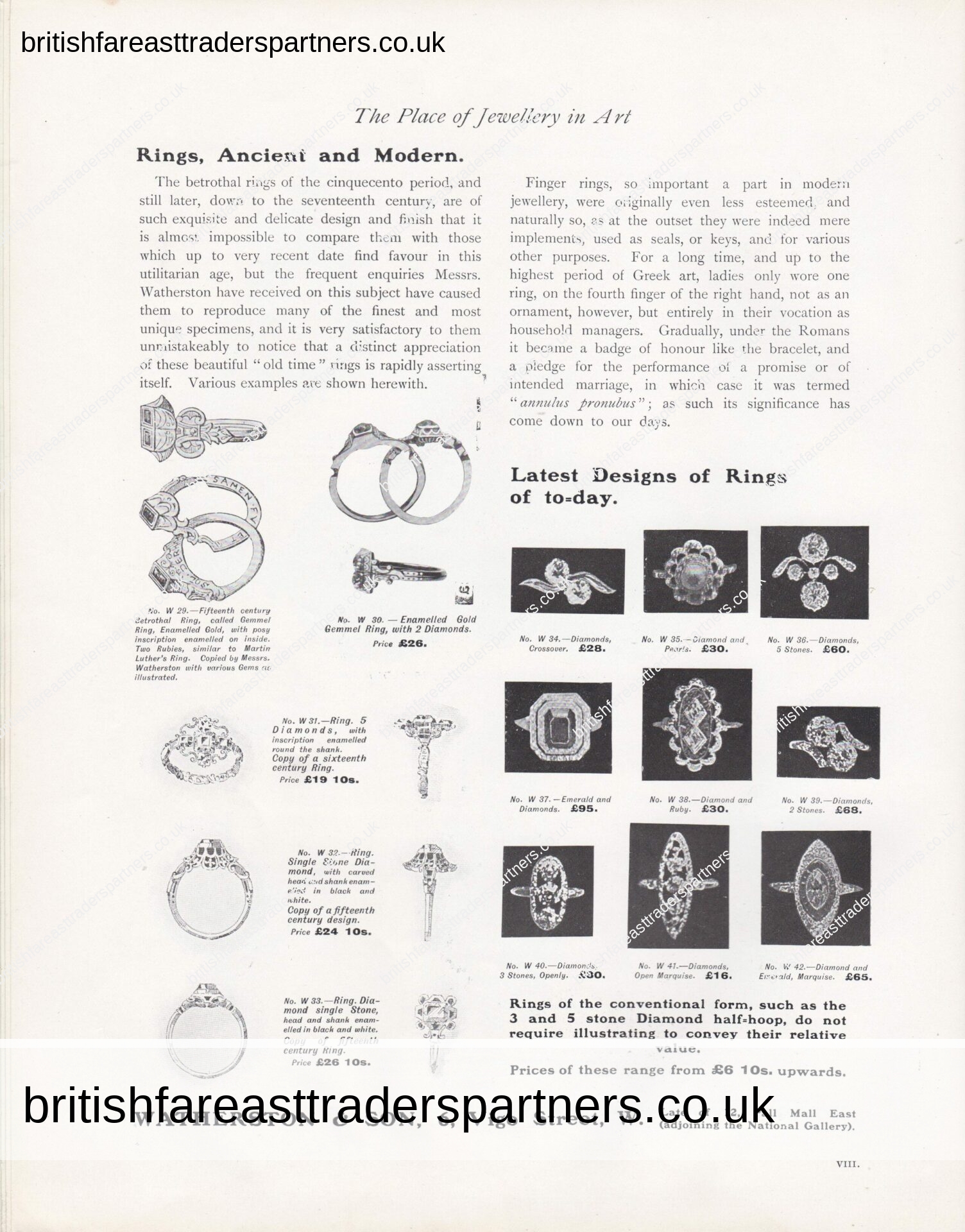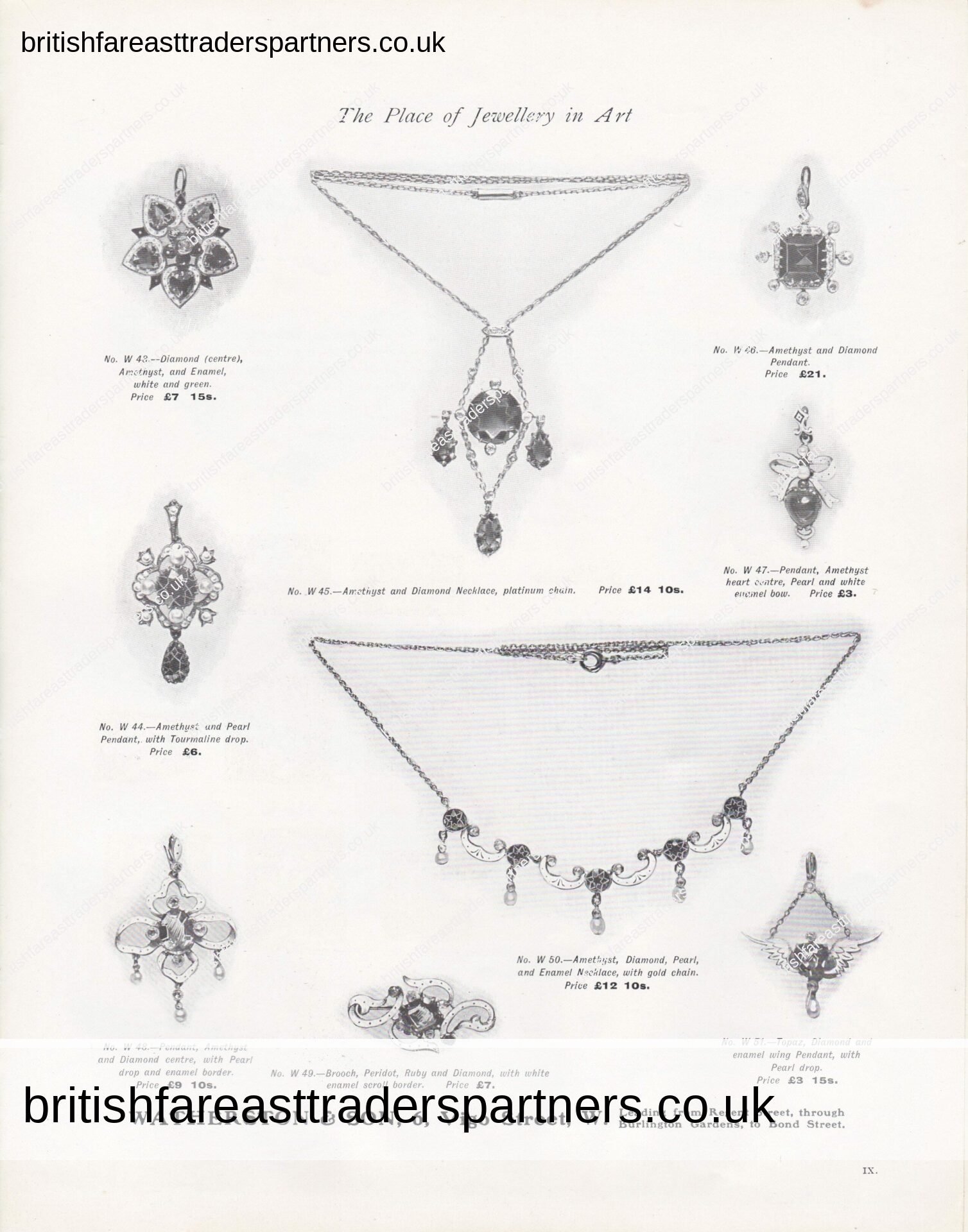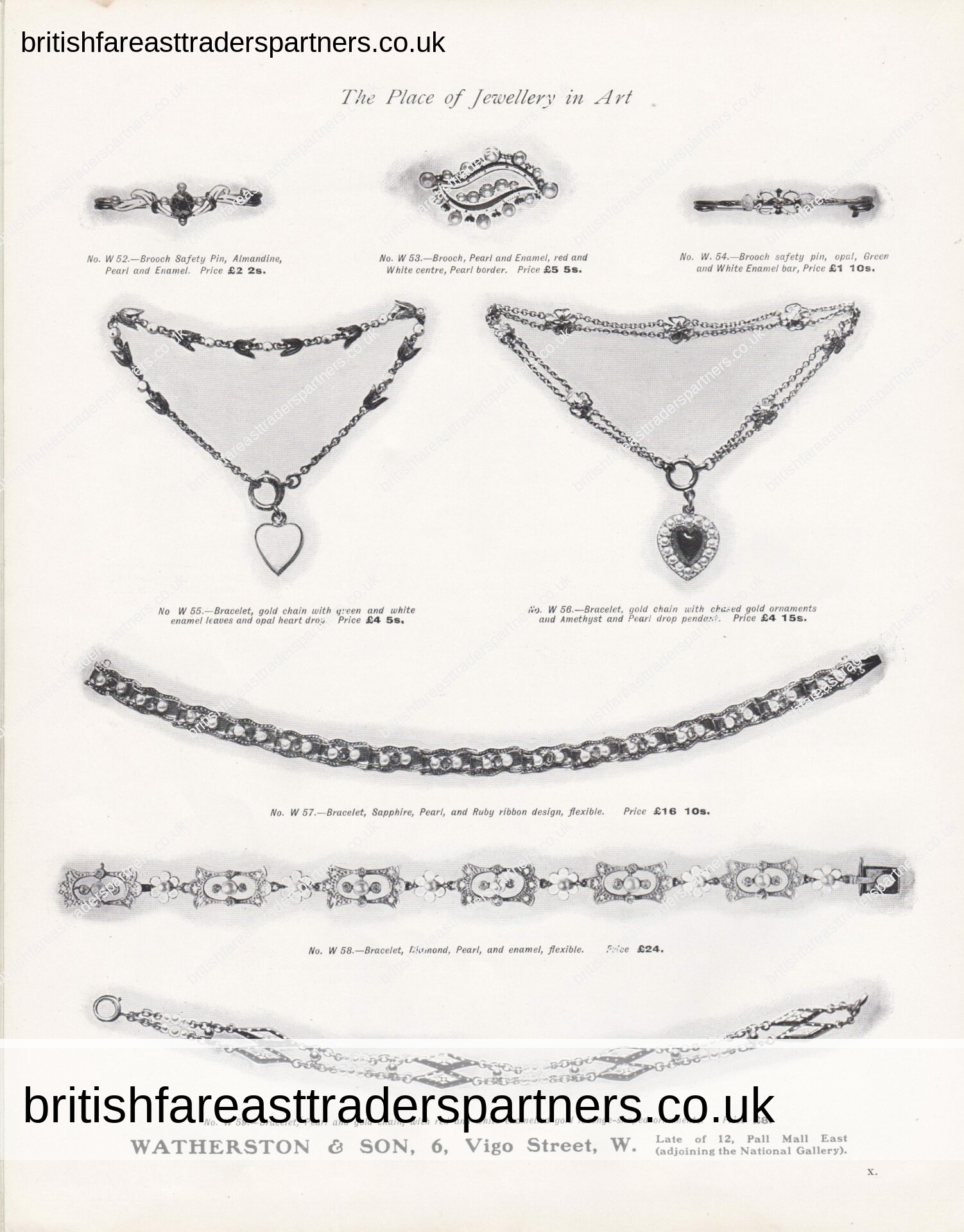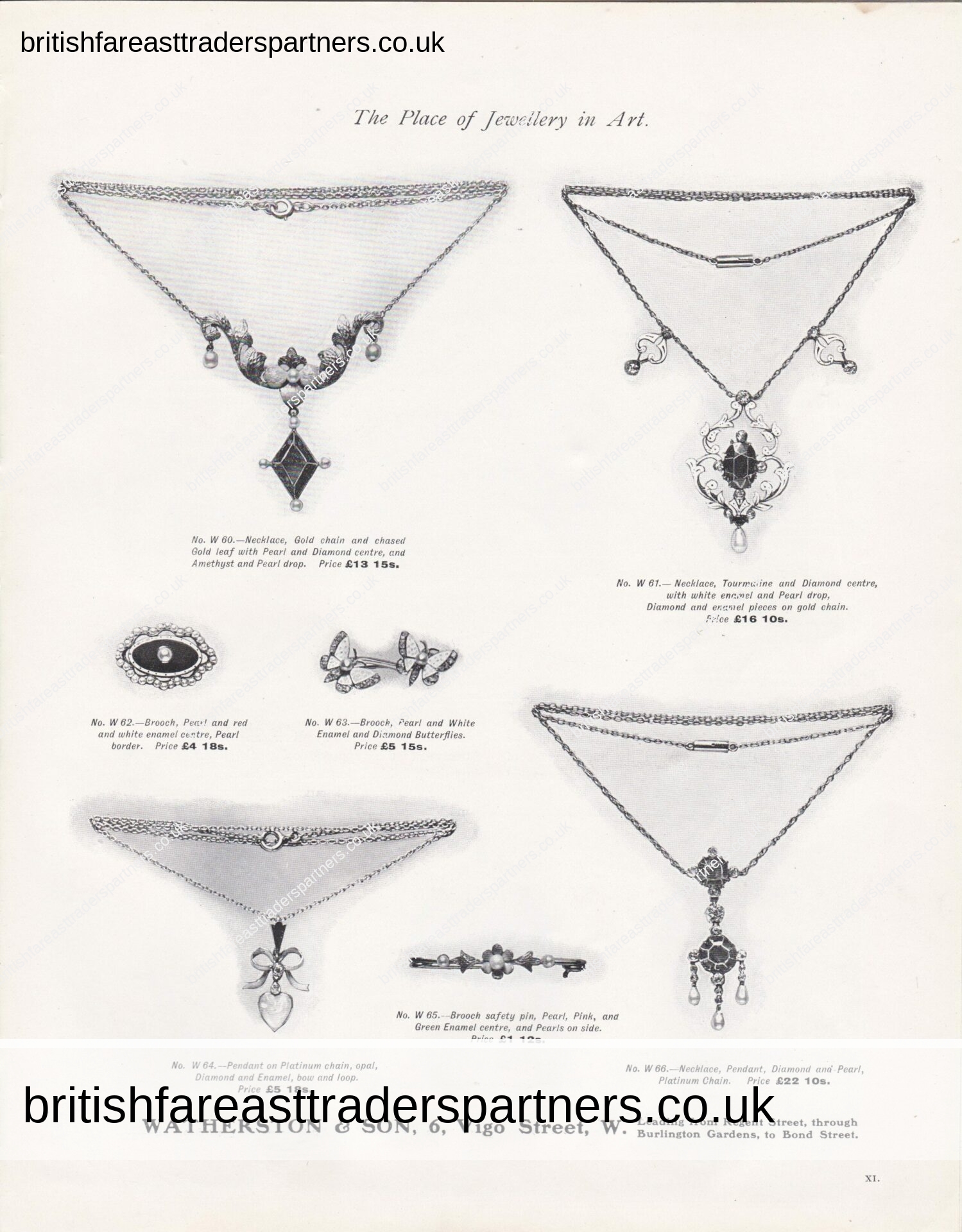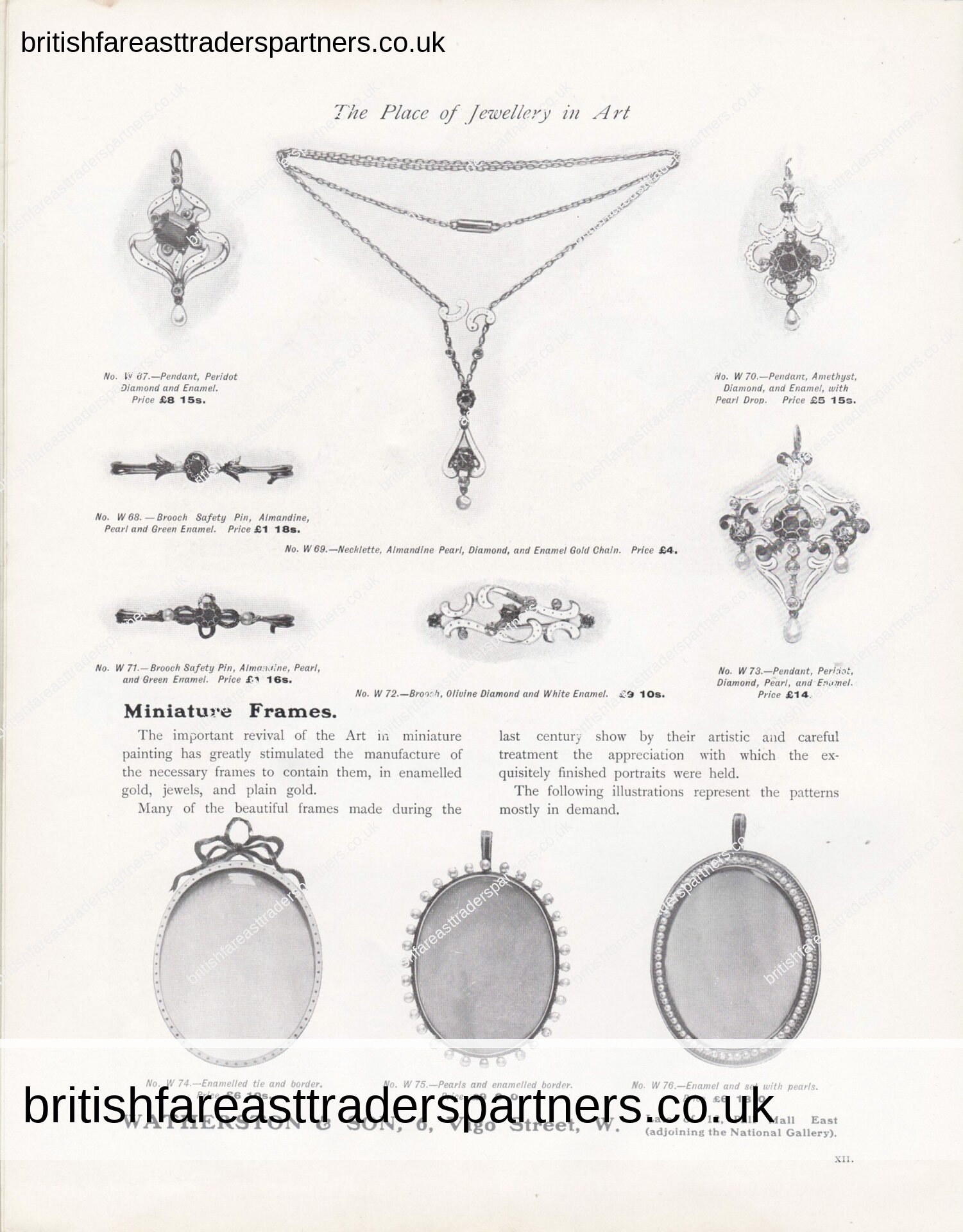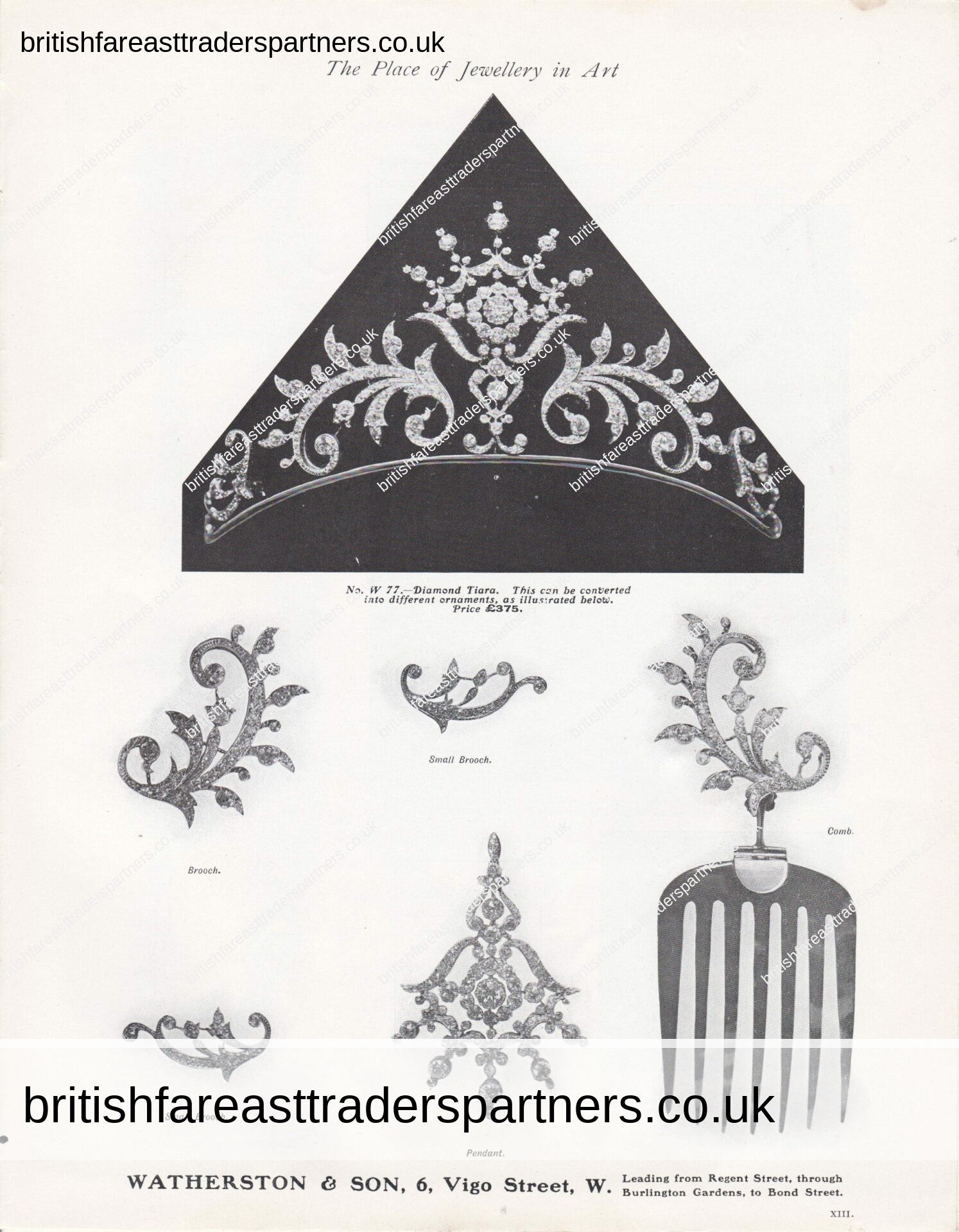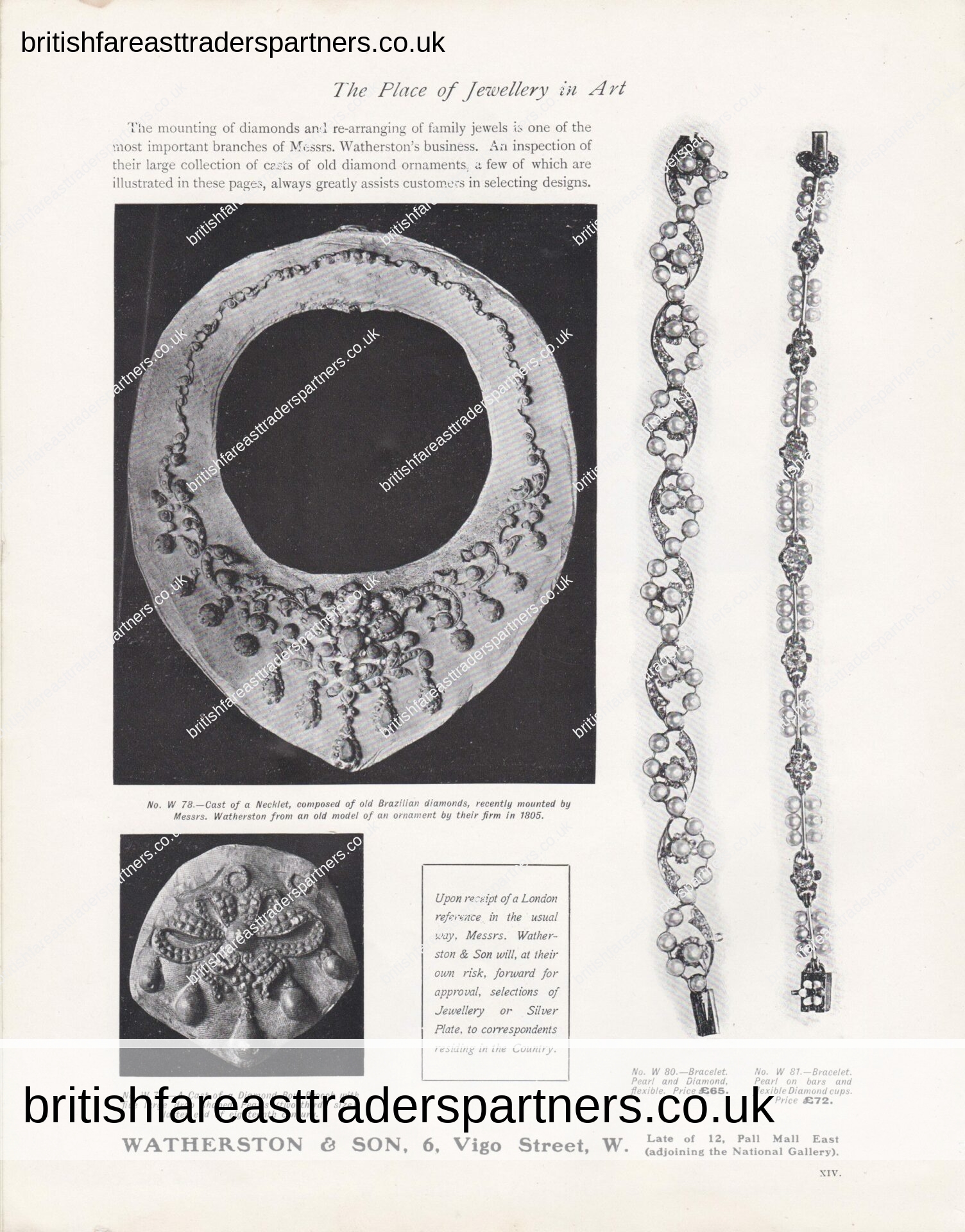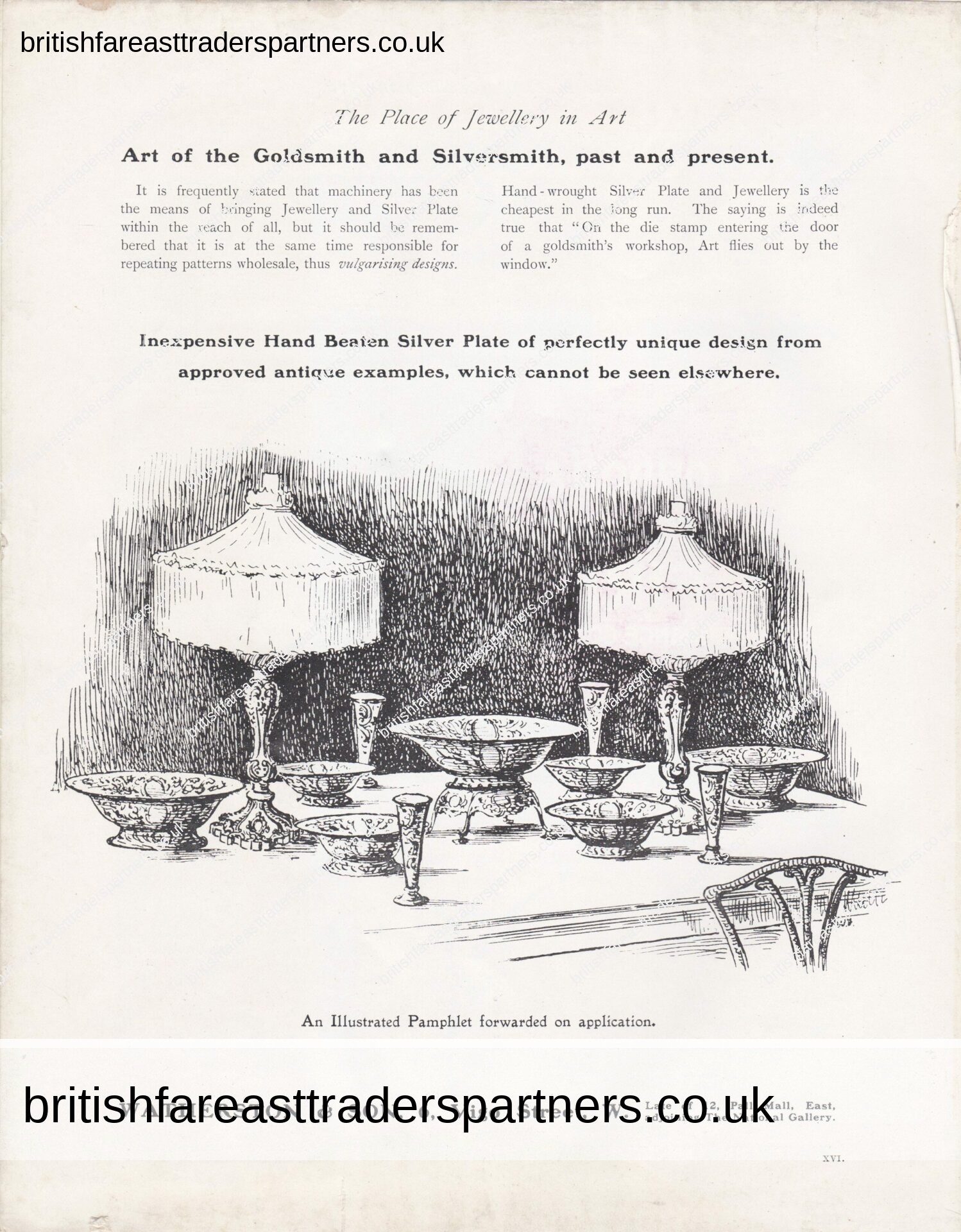Last Updated on: 22nd February 2024, 09:29 pm
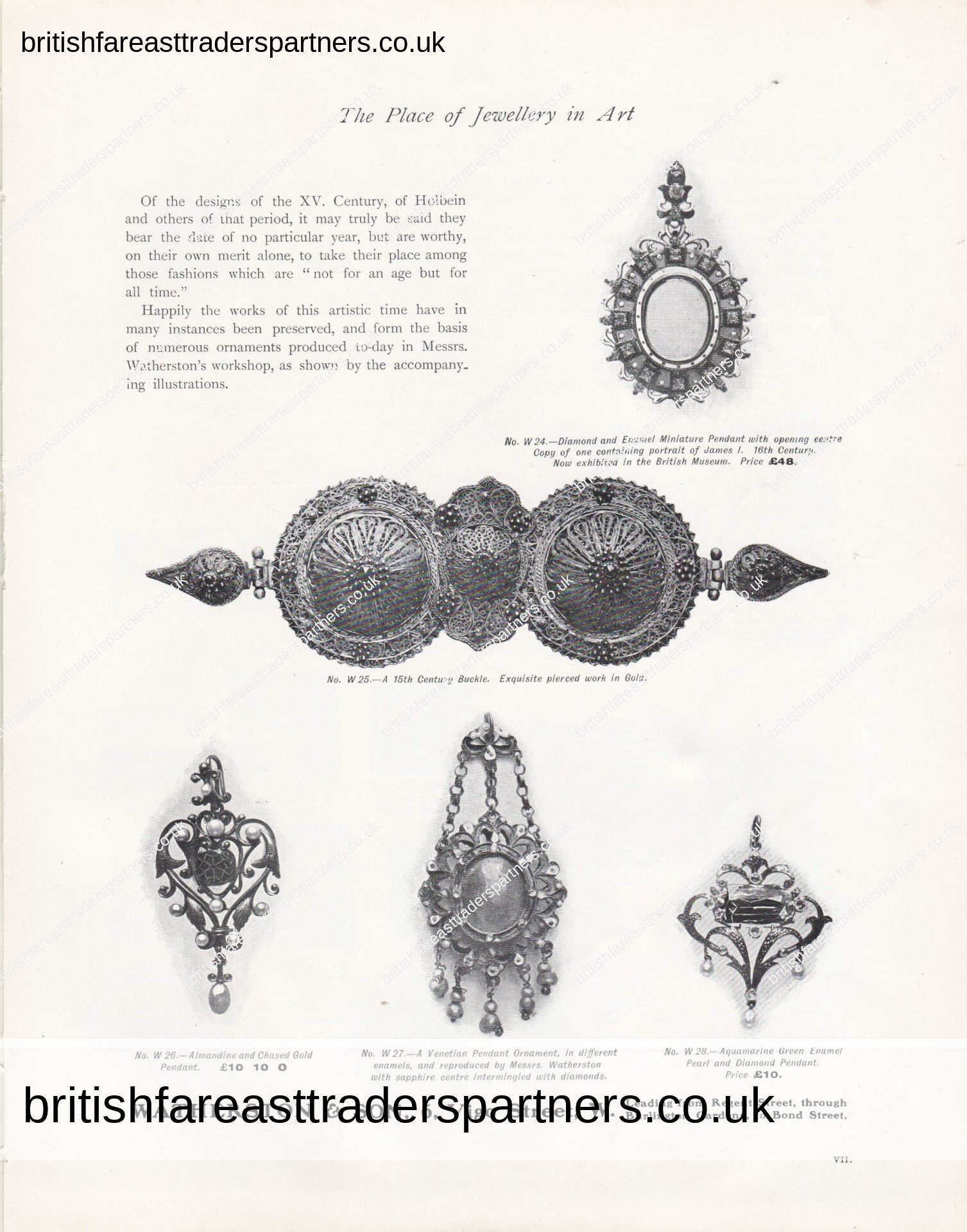
- britishfareasttraderspartners_admin
- ACCESORIES, ADVERTISING, ANTIQUE, BRITISH, COLLECTABLES / COLLECTIBLES, CULTURE, ENGLAND, EPHEMERA, ETHNOGRAPHIC, EUROPE / EUROPEAN, FASHION, HERITAGE, HISTORY, HOBBIES / PASTIMES, INSPIRE ME, LIFESTYLE, LONDON, UNITED KINGDOM
- 1906, Antiques, British, Collectables / Collectibles, England/ English, Jewellery, The Connoisseur (London), United Kingdom, Watherston & Son (London)
Antique May 1906 ‘The Place of Jewellery in Art’ The Connoisseur LONDON Article
Table of contents
Measurements: 8 5/8 inches x 11 inches
No. of pages: 16 pages
Publication: The Connoisseur: A Magazine for Collectors. The Connoisseur (Illustrated), May 1906, Vol. XV No.57. Published by Otto Limited at Carmelite House, Carmelite Street, London, E.C.
Editorial and Advetisement Offices of ‘The connoisseur’: 95, Temple Chambers, Temple Avenue, E.C.
Featured Brand / Business/Organisation: Watherston & Son, 6 Vigo Street, W. Leading from Regent Street, through Burlington Gardens, to Bond Street
Date: May 1906
Paper: n/a
Notes / other details: 16 pages of original feature article taken from The Connoisseur Magazine.
The Place of Jewellery in Art
How the old-world designs govern the new and are reproduced today in a modified form.
The following illustrations of casts of ancient ornaments are only a few of the multifarious collection which interest purchasers and collectors, as showing Mr. Watherston’s method of utilising the designs in order to adapt them to modern requirements, and go to prove that the wearers of jewellery today are instinctively returning to the old Greek models, and not merely gratifying the passing whim of an ever-changing fashion.
Art in dress in- includes art in theme of personal ornaments, whether in gold, silver, or precious stones. Many efforts have been made in modern times to elevate the feeling of true art in relation to jewellery, and to spread a knowledge of it through all classes. Jewellery is not only a part of dress or costume, but it is older than any other form of apparel. The bit of ornament, the necklace, the bracelet, was chosen with the object of adding to personal beauty, with a sort of instinctive feeling for symmetry. The Greeks, “our masters in Art,” and to some extent likewise, their art pupils, the Romans, continued to execute for a period of upwards of three hundred years works surpassing in chaste beauty any that had ever before appeared, and which have not been equalled during the two thousand years which have since elapsed. In conformity with all their views of adorning the human figure, the Ancients paid comparatively little attention to such minor ornaments as bracelets or finger rings; they confined themselves to the head and neck.
Nothing can be more exquisitely beautiful than the ornaments on the heads of some of the gods and goddesses of Greece. Next to the decorations for the head, necklaces played a most notable part. It would be difficult to find anything more charming among the ancient necklaces than the three-stringed ornaments of pearls, intermixed with precious stones. Usually, the upper string of pearls hung loosely if it were wished to make the neck appear more slim, and tight if the contrary effect were desired; while the second was composed alternately of pearls and precious stones; and the third, still lower, was entirely of precious stones, carefully selected, in shape and colour, to suit the wearer. The arrangement of these three strings of pearls and precious stones around the necks of the Grecian ladies was artistic to the highest degree.
There are many specimens of beautiful bracelets, of evident Greek manufacture, still in existence. The Bacchæ, Menades, Thyades, and other persons taking part in the festivals of the god Bacchus, and generally called Bacchantes, were the first to wear bracelets, and their use as an ornament extended from them to women of all classes. When men began to adopt the arm-ring or armilla,” and women left off wearing it, the ornament had lost its character, till gradually it became a badge of merit for deeds of military prowess.
The ancient Etruscans and Romans largely used stones for their ornaments, but apparently cared for colour more than lustre, and subordinated both entirely to design represented by gold-work. An important part of the ornaments for the head used by the Greeks and Romans still survives to this day, namely, earrings. But it survives in a very attenuated and altogether inartistic form. The contrast between the usual productions at this day and ancient Greek art is very noticeable.
Art in dress in- includes art in theme of personal ornaments, whether in gold, silver, or precious stones. Many efforts have been made in modern times to elevate the feeling of true art in relation to jewellery, and to spread a knowledge of it through all classes. Jewellery is not only a part of dress or costume, but it is older than any other form of apparel. The bit of ornament, the necklace, the bracelet, was chosen with the object of adding to personal beauty, with a sort of instinctive feeling for symmetry. The Greeks, “our masters in Art,” and to some extent likewise, their art pupils, the Romans, continued to execute for a period of upwards of three hundred years works surpassing in chaste beauty any that had ever before appeared, and which have not been equalled during the two thousand years which have since elapsed. In conformity with all their views of adorning the human figure, the Ancients paid comparatively little attention to such minor ornaments as bracelets or finger rings; they confined themselves to the head and neck.
Nothing can be more exquisitely beautiful than the ornaments on the heads of some of the gods and goddesses of Greece. Next to the decorations for the head, necklaces played a most notable part. It would be difficult to find anything more charming among the ancient necklaces than the three-stringed ornaments of pearls, intermixed with precious stones. Usually, the upper string of pearls hung loosely if it were wished to make the neck appear more slim, and tight if the contrary effect were desired; while the second was composed alternately of pearls and precious stones; and the third, still lower, was entirely of precious stones, carefully selected, in shape and colour, to suit the wearer. The arrangement of these three strings of pearls and precious stones around the necks of the Grecian ladies was artistic to the highest degree.
There are many specimens of beautiful bracelets, of evident Greek manufacture, still in existence. The Bacchæ, Menades, Thyades, and other persons taking part in the festivals of the god Bacchus, and generally called Bacchantes, were the first to wear bracelets, and their use as an ornament extended from them to women of all classes. When men began to adopt the arm-ring or armilla,” and women left off wearing it, the ornament had lost its character, till gradually it became a badge of merit for deeds of military prowess.
The ancient Etruscans and Romans largely used stones for their ornaments, but apparently cared for colour more than lustre, and subordinated both entirely to design represented by gold-work. An important part of the ornaments for the head used by the Greeks and Romans still survives to this day, namely, earrings. But it survives in a very attenuated and altogether inartistic form. The contrast between the usual productions at this day and ancient Greek art is very noticeable.
Jewellery of the Cinquecento Period
From the Ancient Greek and Roman, we step to the Cinquecento period, which brought a total change in the character of jewellery in Western Europe. A style began to prevail which, in its best period, of not long duration, produced some of the most artistic and splendid jewels that Europe has seen. Men who were masters in art, not mere craftsmen, notably Vervechio, Piermo del Vaga and Benvenuti Cellini, Albert Dum and Holbein, were either jewellers or designed for the goldsmiths, while England had the great miniature painter Hilliard, who was jeweller to Queen Elizabeth. Fine art was enlisted in the service of the jeweller; or better still, he himself was the artist. As the seventeenth century advanced gems chosen for brilliancy and splendour of effect were gradually more and more sought for, and the improved methods of cutting diamonds invented in the latter part of the fifteenth century came by degrees into vogue.
The examples of the old masters in the goldsmiths’ art are always keenly appreciated by vast crowds whenever exhibited, hence Messrs. Watherston are not surprised at the success which has attended their efforts in reproducing many of the masterpieces of this period.
Of the designs of the XV Century, of Holbein and others of that period, it may truly be said they bear the date of no particular year, but are worthy, on their own merit alone, to take their place among those fashions which are “not for an age but for all time.”
Happily the works of this artistic time have in many instances been preserved, and form the basis of numerous ornaments produced today in Messrs. Watherston’s workshop, as shown by the accompanying illustrations.
The examples of the old masters in the goldsmiths’ art are always keenly appreciated by vast crowds whenever exhibited, hence Messrs. Watherston are not surprised at the success which has attended their efforts in reproducing many of the masterpieces of this period.
Of the designs of the XV Century, of Holbein and others of that period, it may truly be said they bear the date of no particular year, but are worthy, on their own merit alone, to take their place among those fashions which are “not for an age but for all time.”
Happily the works of this artistic time have in many instances been preserved, and form the basis of numerous ornaments produced today in Messrs. Watherston’s workshop, as shown by the accompanying illustrations.
Rings, Ancient and Modern
The betrothal rings of the Cinquecento period, and still later, down to the seventeenth century, are of such exquisite and delicate design and finish that it is almost impossible to compare them with those which up to very recent date find favour in this utilitarian age, but the frequent enquiries Messrs. Watherston have received on this subject have caused them to reproduce many of the finest and most unique specimens, and it is very satisfactory to them unmistakeably to notice that a distinct appreciation of these beautiful “old time” rings is rapidly asserting itself. Various examples are shown herewith.
Finger rings, so important a part in modern jewellery, were originally even less esteemed, and naturally so, as at the outset they were indeed mere implements, used as seals, or keys, and for various other purposes. For a long time, and up to the highest period of Greek art, ladies only wore one ring, on the fourth finger of the right hand, not as an ornament, however, but entirely in their vocation as household managers. Gradually, under the Romans, it became a badge of honour like the bracelet, and a pledge for the performance of a promise or of intended marriage, in which case it was termed “annulus pronubus”; as such its significance has come down to our days.
Finger rings, so important a part in modern jewellery, were originally even less esteemed, and naturally so, as at the outset they were indeed mere implements, used as seals, or keys, and for various other purposes. For a long time, and up to the highest period of Greek art, ladies only wore one ring, on the fourth finger of the right hand, not as an ornament, however, but entirely in their vocation as household managers. Gradually, under the Romans, it became a badge of honour like the bracelet, and a pledge for the performance of a promise or of intended marriage, in which case it was termed “annulus pronubus”; as such its significance has come down to our days.
Miniature Frames
The important revival of the Art in miniature painting has greatly stimulated the manufacture of the necessary frames to contain them, in enamelled gold, jewels, and plain gold.
Many of the beautiful frames made during the last century show by their artistic and careful treatment the appreciation with which the exquisitely finished portraits were held.
The following illustrations represent the patterns mostly in demand.
The mounting of diamonds and re-arranging of family jewels is one of the most important branches of Messrs. Watherston’s business. An inspection of their large collection of casts of old diamond ornaments, a few of which are illustrated in these pages, always greatly assists customers in selecting designs.
Many of the beautiful frames made during the last century show by their artistic and careful treatment the appreciation with which the exquisitely finished portraits were held.
The following illustrations represent the patterns mostly in demand.
The mounting of diamonds and re-arranging of family jewels is one of the most important branches of Messrs. Watherston’s business. An inspection of their large collection of casts of old diamond ornaments, a few of which are illustrated in these pages, always greatly assists customers in selecting designs.
Art of the Goldsmith and Silversmith, past and present
It is frequently stated that machinery has been the means of bringing Jewellery and Silver Plate within the reach of all, but it should be remembered that it is at the same time responsible for repeating patterns wholesale, thus vulgarising designs.
Hand-wrought Silver Plate and Jewellery is the cheapest in the long run. The saying is indeed true that “On the die stamp entering the door of a goldsmith’s workshop, Art flies out by the window.”
Hand-wrought Silver Plate and Jewellery is the cheapest in the long run. The saying is indeed true that “On the die stamp entering the door of a goldsmith’s workshop, Art flies out by the window.”
Related posts:
- ANCIENT POST MEDIEVAL ISLAMIC GOLDEN SEAL REDDISH GEMSTONE INTAGLIO RING ANCIENT POST MEDIEVAL ISLAMIC OTTOMAN RING GOLDEN GILDED SIGNET SIGIL...
- VINTAGE ADVERTISING MESSRS. CHRISTIE , MANSON & WOODS THE IMPORTANT COLLECTION OF FINE OLD ENGLISH GLASS FORMED BY THE LATE JOSEPH BLES ESQ. EXHIBITED AT THE VICTORIA AND ALBERT MUSEUM LONDON ON TUESDAY, MAY 14, 1935 GREAT ROOMS , KING STREET, ST. JAMES’S SQUARE LONDON, S.W. 1 FROM THE ILLUSTRATED LONDON NEWS MAY 4, 1935 ANTIQUARIAN & COLLECTABLES | FINE OLD ENGLISH GLASS | ADVERTISING | PRINTS | EPHEMERA VINTAGE ADVERTISING MESSRS. CHRISTIE , MASON & WOODS...
- DAYS OUT IN UNITED KINGDOM: PLACES OF INTEREST in WEST SUSSEX, ENGLAND: A SERIES OF PHOTOGRAPHIC BLOG: ARUNDEL CASTLE GROUNDS & ARUNDEL CASTLE WATER GARDEN : A WORLD HERITAGE SITE : HERITAGE | ART | HISTORY | TOPOGRAPHY | TOURISM | TRAVEL | ARCHITECTURE | ARISTOCRACY | CULTURE SHOP OUR ONLINE STORE… Click Here SHOP OUR EBAY:...
- ANCIENT POST MEDIEVAL ISLAMIC GOLDEN SEAL SCORPION ON AGATE INTAGLIO RING ANCIENT POST MEDIEVAL ISLAMIC OTTOMAN RING GOLDEN GILDED SIGNET SIGIL...
- VINTAGE Blue & White “SORRENTO, ITALY” CERAMIC PITCHER JUG VASE Welcome to our listing for a beautiful vintage Blue &...
- Elegant Retreat at East Sussex National Hotel: Golf, Business & Leisure Discover the ultimate escape at East Sussex National Hotel in...
- VINTAGE “JAPANESE MEN & WOMEN in TRADITIONAL KIMONO Reading Scripts” JAPAN PHOTO VINTAGE JAPANESE PHOTOGRAPH "JAPANESE MEN WOMEN IN TRADITIONAL KIMONO DRESS...
- Discover Sussex’s Idyllic Villages & Tranquil Churches in South Downs Explore the serene churches and picturesque villages nestled in Sussex's...
- ANTIQUE “The Reconciliation JOHN A. LOMAX” LONDON ENGLAND POSTCARD ANTIQUE POSTCARD "THE RECONCILIATION" ANTIQUE | ENGLAND | ART BEAUTY...
- TREE OF LIFE 925 SILVER JEWELLERY MOTHER OF PEARL | ABALONE | CORAL EFFECT MADE IN INDONESIA FASHION COSTUME JEWELLERY SHOP OUR EBAY: BritishFarEastTradersLifestyle Click Here TREE OF...

